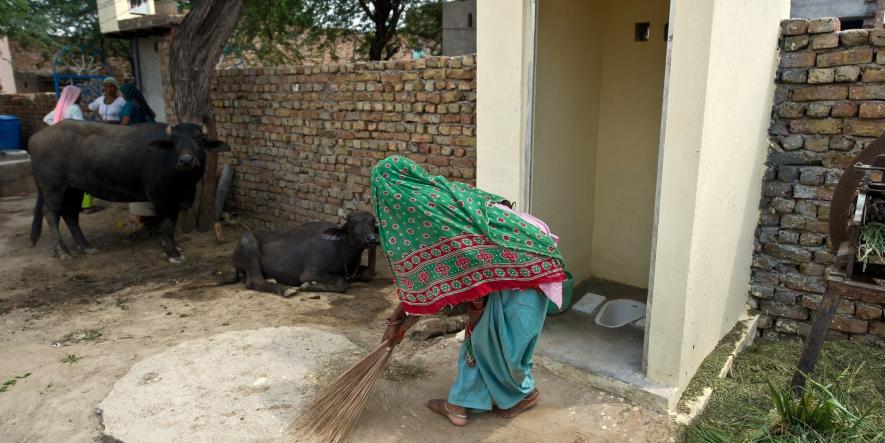‘Toilet Vigilantism’: Ridicule to the Core!

Image Courtesy: HuffPost
‘TOILET vigilantism’, being practised in different parts of the country, has made the already vulnerable social divide starker. The government under the Swachh Bharat Mission has set a goal of constructing toilets to make the country open defecation free (ODF). Recently, a Hindi film too dealt with the importance of construction of toilets in villages. There is nothing wrong in it and in fact there is a dire need to have toilets in all households. But the desperation shown and the draconian method of ‘toilet vigilantism’ has even widened the social gap in the countryside. Whether this will be able to solve the actual problem is a big question mark.
We have witnessed the murder of Zafar Hussein in Pratapgarh in Rajasthan on June 16. He was lynched for objecting to municipal employees clicking pictures of women defecating in the open. There are also reports of women being kept on vigil to face men defecating in the open, thus exposing them for more vulnerability in the early hours of the day. A newspaper report from Rajasthan highlighted that schoolteachers, especially female teachers, are being coerced to work on this vigilantism model where they are forced to mark their attendance in the “shit fields” instead of classrooms. Interestingly, if she fails to mark her attendance by clicking selfies in the fields, surrounded by the villagers who go out to relieve themselves then she will face disciplinary action. Another feature of this is that though such women are supposed to stop women from defecating in the open, it is not necessary that they will only encounter women. Such drives initiated by the district administration involves teachers, anganwadi workers, auxiliary nurses, midwifes and other stakeholders to promote the cleanliness mission. Such photographs taken in the fields are then sent to the principals of the schools who will then forward it to the respective sub-divisional magistrates. Another teacher from the same district reported that she was on the verge of retirement and it became difficult for her to take photographs of the people, especially men defecating in the open. It is ridiculous, she lamented.
According to another report, “In the zeal to be open defecation-free (ODF) for cash rewards, several towns and villages have gone into an overdrive. An elderly man with an upset stomach was slapped and forced to clean up with his dhoti after relieving himself in Ujjain, while another was forced to do sit-ups, pants down. Villagers in Rajasthan are being stripped off government benefits, including subsidised ration supply, while a panchayat in Tamil Nadu denied work under the MGNREGA to those not having a toilet at home.”
Such violent means further deepen the existing social divides because the victims tend to be mostly poor and lower caste, not having enough means to build a toilet or a proper water supply at home. Zafar Hussein had complained many a times to the government departments about non-release of funds for toilets and lack of a water source in his habitation.
Much is stated about the construction of toilets but how this waste is treated is not the concern of the state. The Central Pollution Control Board (CPCB) has carried out an inventorisation of sewage treatment plants (STPs) located in India in 2014-15. There are 816 STPs having capacity of 23,277MLD in 28 states/UTs. The data from the government website reveals that of the 816 municipal sewage treatment plants, only 64 per cent were functional. What happens to the waste is anybody’s guess. The total sewage generated from Indian cities was 62 thousand MLD, but only 30 per cent was getting treated which means the waste untreated goes back into the human cycle and contaminates water which leads to large number of water borne diseases.
According to the CPCB, the domestic sewage is the biggest polluter of our water sources. The incidents of contamination happening due to leakage from the sewerage network to water supply lines are also not uncommon. Shimla happens to be a classic case of contamination of water sources where the untreated STP flow into the water source in Ashwini Khad leading to epidemic of Hepatitis and death of over 20 people and infection of over 2,000.
What is required is a syncretic planning and integration of various forms both conventional and modern for the development of these toilets. For example, several villages in the cold desert regions of Kinnaur, Lahaul and Spiti and Ladakh still use the dry latrines and use the excreta in their farms. This way the soil nutrients we get through food return to the soil and help grow more food. Using water in toilets breaks this cycle as decomposition takes longer and promotes diseases, including superbugs. Apparently, the best apples produced in the country from the two villages, called Nako and Chango, in Kinnaur use this method of manure. A new buzz word now that is being spread is about human waste as the biggest source, but how it is to be used, there are no guidelines and ambiguity exists widely.
This is not to say that toilets are not needed. The problem is with the way toilets are being thrust upon people. This coercion of forcing toilet vigilantism not only makes the lives of women more miserable but also is harassment to such individuals who are not keen to do this exercise of policing. This coercion at the behest of the state is another form of vigilantism akin to cow policing where specific groups are being targeted. It is not easy for people living in cities to manage their waste, but for the time being we can regulate instead of criminalising open defecation in villages. It must be ensured that no more Zafar Husseins die because of the government’s desperation for open defecation free status.
Disclaimer: The views expressed here are the author's personal views, and do not necessarily represent the views of Newsclick.
Get the latest reports & analysis with people's perspective on Protests, movements & deep analytical videos, discussions of the current affairs in your Telegram app. Subscribe to NewsClick's Telegram channel & get Real-Time updates on stories, as they get published on our website.
























